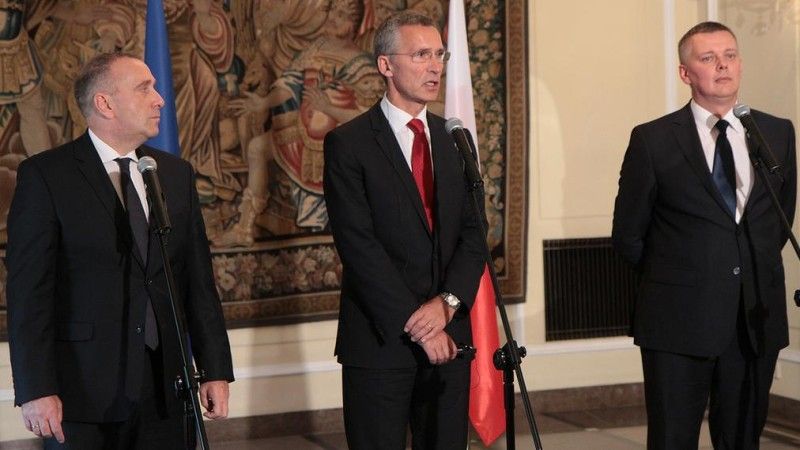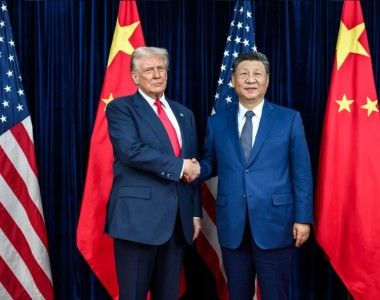Visit without a Breakthrough. NATO Problems will not be Solved by Stoltenberg, they will be Solved by the Member States

During his visit in Poland, NATO Secretary General stated that the main duty of the Alliance is to protect all of its members and thus, the Newport Summit provisions will be realized. The questions regarding reinforcement of the Armed Forces of the NATO Member States or increased defence spending still remain unanswered.
During his visit to Poland, Jens Stoltenberg stated that NATO will maintain “continuous presence and activity” in the Mid-Eastern European states, in response to the Russian Threat. He emphasised the fact that the activities undertaken have a defensive character, which means that they do not breach any international memorandums. NATO Secretary General also visited the Łask AB, where, beside the F-16 jet fighters, E-3A Sentry AWACS and Luftwaffe’s Eurofighter jet were presented.
Jens Stoltenberg also stated that the provisions made during the Newport summit will be realized, while the final decision regarding the number of troops spearhead will consist of is to be made in February next year. During the talks the Middle-East situation was also mentioned – especially within the perspective of potential danger for the NATO countries in the southern part of Europe.
No breakthrough?
Despite the assurance from the NATO Secretary General, effectiveness of the NATO collective defence system still raises many doubts and questions need to be asked. If representatives of individual member states do not make any decision regarding a significant reinforcement and increase of the capabilities of the Armed Forces (which also would involve a financial effort), the Alliance’s defence system may not be effective, should a large scale danger occur.
It is even more significant, due to the fact that in accordance with the statement the new NATO Secretary General made for the Polish Gazeta Wyborcza Daily, he is a proponent of acting in accordance with NATO – Russia memorandum signed back in 1997. That means that no “significant” NATO forces may be stationed in Mid-Eastern Europe. Jens Stoltenberg stressed the fact that he is a proponent of dialogue with Ruussia. At the same time he noted that “there is no contradiction” between creating a collective defence system and developing relationship with Russian Federation. In the circumstances described, the quick reaction capability in response to sudden danger becomes even more important. Ability of providing quick help to the allies is still questionable, due to the financial cuts happening both in the US, as well as in Europe.
Reinforcement of the armed forces and increase of defence spending needed
The US is currently involved in Iraq, the budget of the Department of Defense is currently undergoing cuts resulting from the Budget Control Act. At the same time, the European countries mostly do not meet the requirements according to which NATO member states are to spend 2% of their GDP on defence. The financial limitations forced the Europeans to introduce structural reductions. These had a detrimental effect on quick reaction capabilities, especially in case of threats which may occur simultaneously in several places at the same time.
In order to realize what the situation NATO may find itself in, we may refer ourselves to the example of the Dutch Air Force, which in the recent years has reduced the number of the combat aircraft in operation. Now, due to the involvement in Poland and Middle East, over 20% of the combat aircraft of the RNLAF are used operationally for non-planned operations (taking into account the reserves that have been created). It is still unknown, to what extent the Dutch would be able to expand the scope of their involvement in case of danger with a higher degree of intensity (a conflict that would involve an enemy who has an advanced air defence system at his disposal, who is able to have an advantage over the enemy etc.). In Germany most of the air force jets is not combat-ready, which would obviously make it harder for Luftwaffe to use larger forces in any allied operation.
What about nuclear deterrence?
Another issue which remains an ambiguity is Jens Stoltenberg’s attitude towards the NATO nuclear deterrence system. Back in the 1990’s he was involved in protests against the nuclear tests carried out by France. At the same time, the policy of unilateral reductions of the NATO nuclear arsenal (primarily the US nuclear arsenal) did not result in limiting the Russian nuclear warfare capabilities. The situation is exactly opposite – the Russians reconstruct and modernize their nuclear arsenal, introduce new, dangerous means of delivery, such as Iskander missiles (which could result in breaching the INF treaty regarding the Iskander-K variant). If NATO decides to further reduce its nuclear capabilities the effectiveness of the deterrence system may be questionable. It is particularly dangerous within the context of media reports of some Russian decision-makers considering a nuclear strike on Mid-Eastern European countries, should NATO intervene in the region within the scope of the collective defence activities.



